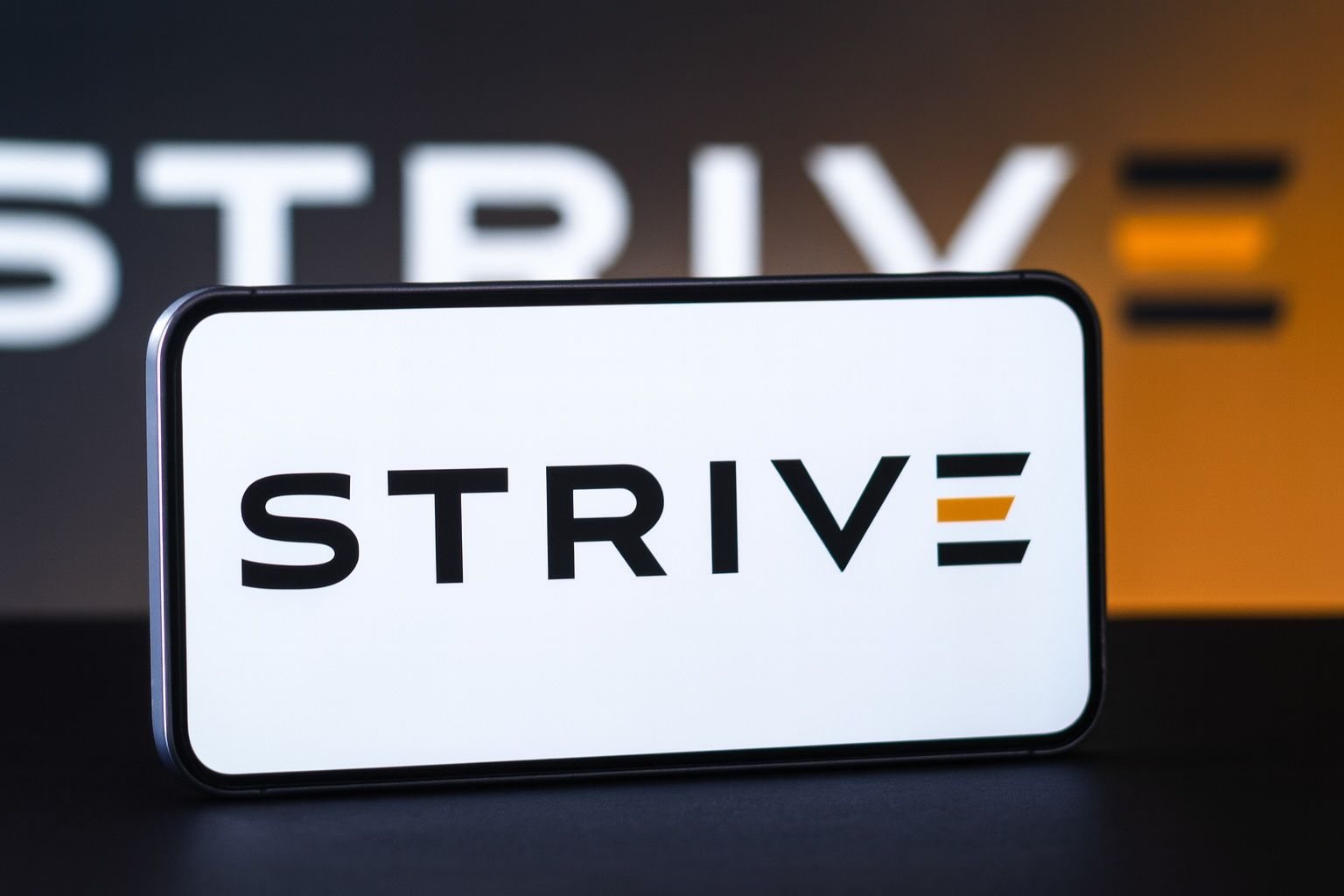- Company: Strive, Inc. (NASDAQ: ASST) is an asset manager founded in 2022 (co‐founded by Vivek Ramaswamy) known for launching anti‐ESG ETFs and pivoting to Bitcoin treasuries [1] [2]. It touts itself as “the first publicly traded asset management Bitcoin treasury company,” aiming to “increase Bitcoin per share” to beat Bitcoin’s return [3]. Its subsidiary (Strive Asset Management, LLC) now oversees over $2 billion in assets (from ETFs launched in Aug 2022) [4].
- Major Deals: In Sept 2025 Strive went public via a merger (ticker ASST) and raised ~$750 million to build a “Bitcoin war chest” [5]. It recently agreed to acquire Semler Scientific in an all‐stock ~$1.34 billion deal (announced Sept 22, 2025), exchanging ~21 Strive shares per Semler share (a ~210% premium). That adds about 5,816 BTC for $675M, bringing the combined Strive/Semler company to roughly 11,000 BTC held [6] [7]. (Strive also bought MSTR True North Inc. in mid-Sept as part of its Bitcoin‐advocacy strategy [8].)
- Stock & Performance: ASST stock has been extremely volatile. In 2025 it traded between $0.34 and $13.42 [9]. After summer highs around $13, the stock plummeted to roughly $1.55 by Oct 10, 2025 [10] [11]. It fell 14% on Oct 10 and plunged another ~32% in after-hours trading on Oct 10 (to ~$1.05) when news broke that Strive registered 1.283 billion new shares for resale [12] [13]. This massive share offering (by insiders) sent the price sharply lower. As of Oct 11, 2025, ASST was hovering in the mid-$1 range.
- Recent News (Oct 2025): In the past week Strive made headlines by: (a) Appointing a new CIO (Ben Werkman) on Oct 6, 2025, to lead its Bitcoin investment strategy [14] [15]; and (b) Filing an SEC prospectus (Oct 10) to allow insiders to sell 1.283B shares (no cash to Strive) [16]. The latter triggered the sudden stock sell-off. Prior to that, in Sept 2025 Strive completed its SPAC merger (with Asset Entities) and announced its strategy of aggressively buying Bitcoin [17].
- Analyst/Media Commentary: Financial media note that Strive is pursuing a “Bitcoin treasury” playbook like MicroStrategy. Reuters and Bloomberg reported the Semler deal as part of a “consolidation among Bitcoin accumulators” [18] [19]. Strive CEO Matt Cole said the merger “cements Strive’s position as a top Bitcoin treasury company,” enabling it to grow Bitcoin holdings “at an unmatched pace” and deliver “Bitcoin per share” gains [20]. But some observers caution that these stocks are extremely risky: industry analysts like Adam McCarthy (Kaiko) warn DAT (Digital Asset Treasury) stocks are “volatility plays… leveraged exposures” (moving 4–5× Bitcoin’s swings) [21]. Crypto critics accuse some DATs of “self-dealing, dressed up as capital deployment” [22]. Even regulators are scrutinizing the hype: reports say the SEC/FINRA have contacted 200+ firms about unusual trading ahead of crypto-treasury announcements [23].
- Forecasts & Outlook: No major Wall Street firms currently cover ASST, and consensus price targets are unavailable. Given the extreme volatility and dilution risk (new shares), most analysts would view Strive as highly speculative. Its fate will largely track Bitcoin’s price and investor appetite for risk. If Bitcoin rallies, Strive could amplify gains by issuing shares to buy more crypto, but in a downturn its stock could fall faster than Bitcoin [24] [25]. Investors should note Strive’s stated goal to outperform Bitcoin “over the long run” [26], but also be wary of the structural leverage (share issuances) that makes this stock much more volatile than a plain Bitcoin ETF.
Overview of Strive and Its Role: Strive Asset Management began as an ETF issuer and anti-ESG investment firm (co-founded by Ramaswamy in 2022) [27] [28]. In 2025 it transformed into a dedicated Bitcoin-treasury company. Strive’s business is to raise capital (through equity/debt) and convert it into Bitcoin holdings. The company uses a “preferred equity only” leverage model (no debt) to accumulate crypto [29]. By merger and acquisitions, Strive aims to become a large public company that simply hoards Bitcoin. Its own COO calls this building a “scaled, innovative and accretive Bitcoin acquisition platform” [30]. In practice, Strive is effectively a corporatized Bitcoin ETF: shareholders buy Strive stock to get indirect exposure to Bitcoin’s price and the company’s management of that bitcoin hoard.
Recent Developments (Oct 2025): In the last few days Strive’s story has been dominated by capital actions. On Oct 6, 2025 Strive announced that Bitcoin expert Ben Werkman would become its Chief Investment Officer [31]. Werkman – formerly at Swan Bitcoin and a Bitcoin treasury advisor – will oversee capital deployment and risk management, reinforcing Strive’s aggressive crypto strategy. The big shock came Oct 10: Strive filed an SEC 8-K disclosing a prospectus to register ~1.28 billion new shares for resale [32]. These shares are being sold by insiders (no money to Strive), and news of the registration immediately spooked investors. In after-hours trading on Oct 10 the stock cratered ~32% (to ~$1.05) [33]. Over the weekend (Oct 11) it recovered slightly but remains far below its recent highs.
Earlier in Sept 2025, Strive had already completed its SPAC merger (with Asset Entities) and raised about $750M (with an additional $750M in warrant proceeds possible) to begin buying Bitcoin [34]. The company then announced two major moves: (1) acquiring True North Inc. (a Bitcoin media/strategy venture linked to MicroStrategy) on Sept 16 [35], and (2) the Semler Scientific merger on Sept 22 [36]. These deals doubled Strive’s Bitcoin inventory (Semler’s 5,816 BTC plus the earlier assets). Thus, Strive’s pipeline has been non-stop acquisitions and financings geared toward one goal: maximizing Bitcoin per share.
Stock Price & Trends: Strive’s stock (ASST) reflects the wild market swings. It jumped sharply in mid-2025 as crypto prices and investor excitement rose; the 52-week high was about $13.42 [37] (set in summer 2025). But the recent news has reversed much of those gains. The late-Sept mergers and share filings have caused intense selling: by Oct 10 it closed at ~$1.55 [38], a day’s drop of ~14%, then fell further in after-hours to ~$1.05 [39]. For perspective, the stock is down roughly 90% from its peak. (Year-to-date returns remain positive from much lower 2024 levels, but that is now overshadowed by the late crash.) Volume has been very high, reflecting the volatility. Analysts note that in many cases Strive’s market cap briefly fell below the value of its Bitcoin holdings – a sign of how cheaply the market is now valuing these Bitcoin-treasure plays [40].
Expert Commentary: Industry experts are divided. Some see Strive as the vanguard of a new corporate crypto trend. For example, blockchain investor Ryan Watkins has argued that well-run “DAT” firms could become “the Berkshire Hathaways of their blockchains,” using crypto treasuries to fund projects and infrastructure [41]. Peter Smith (CEO of Blockchain.com) has cheered the rise of DATs, saying it’s “capitalism…awesome” and predicting more consolidation by the strongest players [42]. On the other hand, many analysts urge caution. A Reuters summary noted that after the summer crypto mania, many DAT stocks “suffered sharp drops” and were re-priced much lower as euphoria faded [43]. Kaiko’s Adam McCarthy emphasizes that these companies are “volatility plays” – if Bitcoin falls 3%, DAT stocks might fall 4–5× as much [44]. Crypto veteran Kadan Stadelmann even labeled the DAT craze “self-dealing, dressed up as capital deployment” [45], implying the strategy is more hype than substance. Furthermore, regulators (SEC/FINRA) have already contacted over 200 firms that announced crypto treasury plans, warning of potential insider trading risks [46].
Forecasts & Analyst Views: Because Strive is so new and unusual, there are few (if any) independent analyst reports or price targets. Most investment research houses have not covered ASST, and no consensus forecasts exist. (Available consensus data and price‐target tools on sites like Yahoo or Investing.com currently show “n/a” or require login [47] [48].) Given Strive’s stated strategy, its future will closely mirror Bitcoin’s price moves, but amplified. In a rising market, Strive can issue stock to buy more BTC, boosting its crypto “per share.” In a downturn, dilution can accelerate losses. As one ts2.tech analysis notes, DAT stocks trade like “leveraged vehicles” [49] [50]. In practice, if Bitcoin runs higher (some crypto strategists expect mid-2020s targets for BTC well above $200K), Strive could compound those gains. But many analysts warn that in the current environment of scrutiny and market jitters, ASST remains highly speculative. Investors interested in Strive should be prepared for big swings and keep an eye on Bitcoin’s price, Strive’s share issuance plans, and regulatory news.
Comparison with Peers: Strive operates in a niche alongside companies like MicroStrategy (rebranded Strategy, ticker MSTR), Marathon Digital (MARA), Riot Platforms (RIOT), and niche “DAT” firms. MicroStrategy is the template: a software firm that pivoted to Bitcoin in 2020 and now holds ~600K BTC, with a market cap that soared and fell with crypto [51]. Like MicroStrategy, Strive’s model is to use equity to buy crypto; in fact Strive even acquired True North from MicroStrategy to combine efforts [52]. Unlike Bitcoin ETFs (e.g. GBTC, BITO), Strive is a C-corp: it can stake or lend coins and pursue acquisitions, but it also carries corporate governance and liquidity risks [53]. Its share price can deviate wildly from Bitcoin’s price (as DATs have done) rather than tracking it closely like an ETF [54]. In summary, Strive is essentially a “leveraged, actively managed” crypto play – potentially higher reward than passive ETFs, but far higher risk. Other DATs (e.g. Ton Strategy, BitMine, or gaming companies with crypto treasuries) share the theme, but Strive’s combination of Ramaswamy’s profile and massive fundraising makes it a standout case.
Sources: Official Strive press releases and filings [55] [56] [57]; Reuters and Bloomberg news reports [58] [59]; analysis on DAT trends (ts2.tech, Reuters, CoinDesk) [60] [61]; stock market data on ASST [62] [63]. Each source is cited inline.
References
1. www.globenewswire.com, 2. www.etf.com, 3. www.globenewswire.com, 4. www.globenewswire.com, 5. www.nasdaq.com, 6. www.reuters.com, 7. www.bloomberg.com, 8. www.globenewswire.com, 9. stockanalysis.com, 10. stockanalysis.com, 11. stockanalysis.com, 12. stockanalysis.com, 13. www.tradingview.com, 14. www.globenewswire.com, 15. www.globenewswire.com, 16. www.tradingview.com, 17. www.nasdaq.com, 18. www.bloomberg.com, 19. www.reuters.com, 20. www.globenewswire.com, 21. ts2.tech, 22. ts2.tech, 23. ts2.tech, 24. ts2.tech, 25. ts2.tech, 26. www.globenewswire.com, 27. www.etf.com, 28. www.globenewswire.com, 29. www.globenewswire.com, 30. www.globenewswire.com, 31. www.globenewswire.com, 32. www.tradingview.com, 33. stockanalysis.com, 34. www.nasdaq.com, 35. www.globenewswire.com, 36. www.globenewswire.com, 37. stockanalysis.com, 38. stockanalysis.com, 39. stockanalysis.com, 40. ts2.tech, 41. ts2.tech, 42. ts2.tech, 43. ts2.tech, 44. ts2.tech, 45. ts2.tech, 46. ts2.tech, 47. stockanalysis.com, 48. www.investing.com, 49. ts2.tech, 50. ts2.tech, 51. ts2.tech, 52. www.globenewswire.com, 53. ts2.tech, 54. ts2.tech, 55. www.globenewswire.com, 56. www.nasdaq.com, 57. www.globenewswire.com, 58. www.reuters.com, 59. www.bloomberg.com, 60. ts2.tech, 61. ts2.tech, 62. stockanalysis.com, 63. www.investing.com







